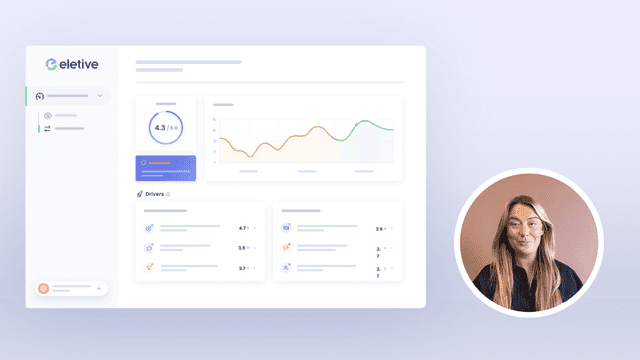Measuring and calculating eNPS (employee Net Promoter Score) is a great way to keep track of how the employee experience – and your employer brand – is evolving.
How to calculate eNPS score
Calculating employee Net Promoter Score (eNPS) is crucial in measuring an organisation’s success and well-being. HR leaders benefit from accurate solutions that simplify the process of calculating eNPS. Identifying enPS scores within your organisation helps you understand employee loyalty rates and devise plans for future improvements.
While eNPS calculation is undoubtedly important, many leaders need help calculating eNPS scores accurately. With this knowledge, organisations can conduct employee surveys that impact the organisation positively.
This article will cover everything about how eNPS calculation works and how it can help you improve the employee experience in your organisation.
What are eNPS scores?
Employee Net Promoter Scores (eNPS) are measurements of employee engagement and loyalty in an organisation. eNPS scores identify and calculate overall employee satisfaction by asking employees if they are likely to refer the organisation to a friend.
eNPS scores help managers, executives, and leaders identify areas of improvement to boost employee satisfaction and retention. A high eNPS score indicates that employees are generally engaged, loyal, and satisfied with their position and the organisation. Because of how essential employee satisfaction is in maintaining an organisation, leaders knowing how to calculate eNPS is critical to a company’s longevity.
Calculating the eNPS Score
Navigating eNPS score calculation seems trickier to many than when conducted with a thorough understanding of the measurement. To calculate eNPS scores, individuals use the formula: eNPS = percentage of Promoters minus percentage of Detractors.
The result of this formula is a numerical answer ranging between -100 and +100. eNPS is calculated by having employees answer one question: how likely are you, on a scale of 0 to 10, to recommend your current employer to a friend or acquaintance?
Employees provide a numerical answer, with ten meaning the employee is highly likely to recommend the organisation and 0 meaning they are not at all likely to recommend it. After the responses are collected, leaders divide the employees into three categories based on their rating:
Promoters (employees with a likelihood rating of 9-10)
Passives (employees with a likelihood rating of 7-8)
Detractors (employees with a likelihood rating of 0-6)
Results are then plugged into the formula mentioned above to gather an overall understanding of employee engagement and satisfaction within an organisation.
Breaking down your eNPS results
After calculating the result of your eNPS survey, it’s time to break down what these results indicate for your organisation. Where your final results land on a scale between -100 and +100 gives you a more conclusive answer on how satisfied your employees are with the organisation.
Any result between -100 and -1 indicates significant organisational and employee satisfaction issues. However, the remaining numbers from 0 to 100 indicate that your organisation is on the right track for employee engagement and satisfaction. Below is a breakdown of what your eNPS results indicate for your company.
0-20: Good
20-50: Very good
50+: Excellent
Going beyond eNPS Scores
While eNPS scores are vital measurements of how successful your organisation is at keeping employees happy and engaged, there are additional ways to expand the survey to get more specific and actionable insights into overall employee satisfaction. Many employers ask employees follow-up questions based on their responses to the initial survey. If your eNPS results aren’t insightful enough, consider asking some of the following follow-up questions anonymously.
What is the reason you selected the assigned score?
In five years, do you see yourself still working for this organisation?
Between 0 to 10, how valued are you at work?
What are you most and least satisfied with in this organisation?
On a scale of 0 to 10, with 0 meaning “not at all” and ten meaning “met my expectations completely,” how much has the organisation met your initial expectations when you were first employed?
Related reading: eNPS follow-up questions – what to ask and why?
What are the benefits of measuring eNPS?
While eNPS surveys give you a clearer picture of how well your organisation performs with employees, other benefits to measuring eNPS make a comprehensive eNPS survey incredibly valuable to a business. Before conducting your first eNPS survey, consider some of the benefits of an accurate and comprehensive eNPS survey.
eNPS is a widely used metric
A massive benefit of using an eNPS survey to measure employee satisfaction and engagement is that eNPS is a widely adopted metric. eNPS is used by businesses globally, making it easy to compare your eNPS survey results with those from organisations in the same industry or country. The eNPS survey is effective because it is globally established as an indicator of employee well-being and is standardised, making it simpler to measure your results and compare them to your competitors.
eNPS can help mitigate staff turnover
Companies can use eNPS surveys to craft a strategy for improving employee well-being and engagement. Organisations with poor or declining eNPS scores can use their results to indicate that organisational change is necessary. With eNPS results and additional follow-up questions, organisations can determine specific factors leading to high staff turnover rates.
eNPS is a great benchmarking metric
One notable benefit of measuring eNPS is that the method is always measurable–it is a score that is always in motion and can significantly increase or decrease over time. Because this metric is not static but remains standardised, it’s one of the best ways to measure employee engagement over the years of your organisation.
Even if you notice employee satisfaction increasing, successive eNPS surveys are essential to guarantee that you will make employees happy and adjust policies when necessary to boost employee well-being. By consistently measuring eNPS, you can gather an overview of employee loyalty.
How Eletive improves your eNPS surveys
Maintaining a high eNPS score is one of the most effective ways to guarantee employee satisfaction and boost engagement within your organisation. However, eNPS scores can offer more profound insights when implementing solutions like Eletive’s survey tools.
Eletive is a platform to help organisations focus on the people. Growing your organisation while simultaneously encouraging employee growth is essential to maintaining your business for years. Eletive is a supplier of employee surveys, including a comprehensive eNPS survey tool to help you understand and calculate eNPS scores in your organisation.
Eletive is an easy-to-use platform aimed at helping you measure employee engagement and building a high-performing culture. Our unique emphasis on self-leadership changes the organizational dynamic and empowers everyone to help build a great workplace – together.


























